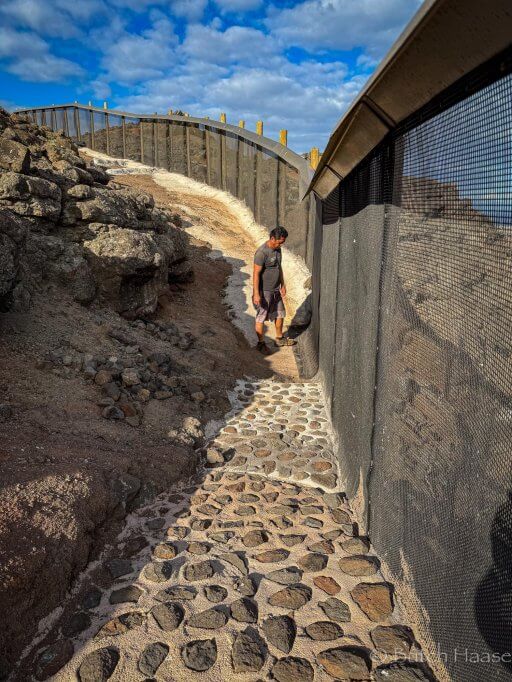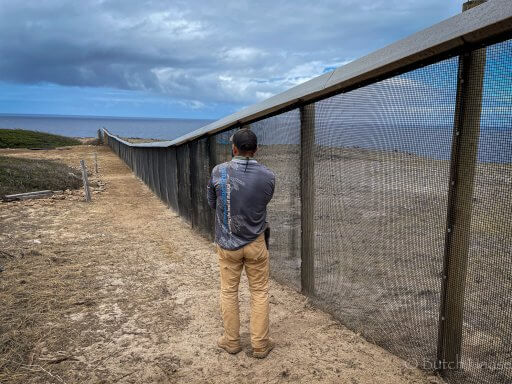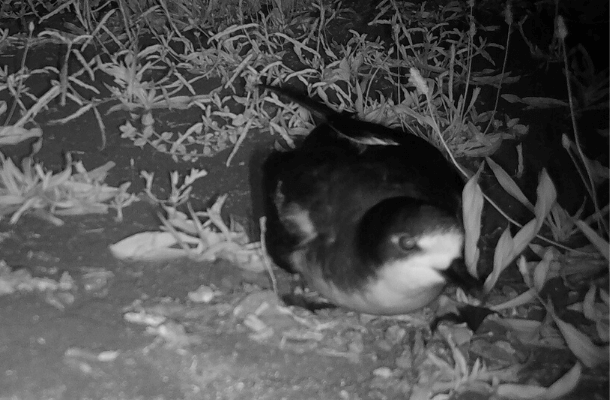Completed Predator-proof Fence on Moloka'i's North Shore Will Provide Safe Haven for Endangered Seabirds


American Bird Conservancy (ABC) and Moloka‘i Land Trust have completed a 5,600-foot-long predator-proof conservation fence at the Mokio Preserve on Hawai‘i's Moloka‘i Island. Vulnerable seabirds, including the Laysan (Mōlī) and Black-footed Albatross (Ka‘upu), will have a chance to replenish their populations inside the nearly 100-acre elevated wildlife sanctuary, safe from sea level rise and invasive predators that prey upon their breeding colonies.
“Seabirds are the most endangered group of birds and restoring their populations on Moloka‘i Island has been a long-term goal of the Mokio restoration partnership,” said Brad Keitt, Oceans and Islands Director at ABC. “We've already begun seeing benefits from the newly installed fence, including Wedge-tailed Shearwater (‘Ua'u Kani) chicks this year, compared to previous years when all chicks were lost to mongoose predation. Through social attraction and active translocation methods, we hope to establish species that are losing their nesting sites due to sea level rise in the Northwest Hawaiian Islands, such as Laysan and Black-footed Albatrosses, Bonin Petrels (Nunulu), and Tristram's Storm-Petrels (Akihikeʻehiʻale).”
Once used as ranch land, years of cattle, goat, and deer traffic that introduced and spread non-native grasses along with the introduction of non-native mammalian predators took a toll on Moloka‘i's native plant, insect, and seabird species. The fence is part of a long-term restoration effort, transforming this site from an area overgrown with non-native buffel grass and kiawe trees to a thriving dune coastal ecosystem that supports numerous endangered plant and pollinator species unique to Hawai‘i.
“Mokio is a special place and it has been phenomenal to see the transformation from a degraded area to thriving native coastal strand habitat with blooming native species carpeting the ground,” says Butch Haase, Executive Director of Moloka'i Land Trust, who has been leading the effort to protect this site since 2009. “It is now possible to stand in the middle of the project and see only native species and ocean, giving people a chance to experience what Hawai'i used to be like. It is our hope that seeing this restored land will inspire others to do the same elsewhere across our islands.”
Construction of the predator-proof fence began in August 2020. Ongoing research and work with Moloka‘i Land Trust and the U.S. Fish and Wildlife Service (USFWS) Coastal Program determined that predator-proof fencing was the most effective means of protecting endangered ground-nesting seabirds, which lack defenses from invasive feral cats, mongoose, rats, and mice that attack adults and eat their eggs or hatchlings.
Even before the fence was complete, evidence of future recovery was appearing. Wedge-tailed Shearwater nesting numbers began increasing. Several Laysan Albatrosses and one Black-footed Albatross have also been documented at the site. They were responding to a social attraction system deployed by ABC researchers and partners, which mimics the sights and sounds of an active albatross colony using a solar-powered sound system that broadcasts albatross sounds and includes decoy albatross models.
“This is truly ecosystem restoration at its best conducted by a coalition of forward thinkers,” said Sea McKeon, Marine Program Director at ABC. “The protected area is huge and will host a tremendous diversity of seabirds, from dancing albatrosses to the haunting night calls of shearwaters, as well as the remarkable endemic community of plants and pollinators that our partners at Moloka‘i Land Trust have painstakingly restored.”

The Mokio Preserve was recently ranked as a top 5 priority location for seabird restoration across all U.S. Pacific Islands in a USFWS review that queried over 70 seabird experts. The site is identified as potential habitat for multiple seabird species. In addition to those mentioned above, these include the Hawaiian Petrel ('Ua'u), Newell's Shearwater (‘A'o), Band-rumped Storm-Petrel (‘Ake‘ake), Bulwer's Petrel (‘Ua‘u), Black Noddy (Noio), White-tailed (Koa‘e ‘kea) and Red-tailed (Koa‘e ‘ula) Tropicbirds, Brown ('Ā) and Red-footed (‘Ā) Boobies, and Great Frigatebird (‘Iwa).
Seabirds are a critical part of coastal and island ecosystems, spending most of their lives foraging for food thousands of miles out on open ocean. They tend to be long-lived, taking several years to mature, and are slow reproducers, having only one chick every one or two years. Often flying to and from their inland nests at night, they are top-level marine predators with a remarkable sense of smell that rivals bloodhounds. Seabird droppings play an important role in supporting marine and terrestrial ecosystems by fertilizing coastal plants, island forests, and nearshore waters. Research has shown that islands with healthy seabird populations have healthier coral reefs and fish populations near them.
“The conservation fence at Mokio Preserve will cause a cascade of positive ecological impacts,” said Sheldon Plentovich, Pacific Islands Coastal Program Coordinator at USFWS. “Increased numbers of nesting seabirds will bring marine-derived nutrients to the land and nearshore areas in the form of guano. This will in turn provide nutrients to coastal plants which will create more habitat for native insects, including endangered pollinators like the Hawaiian Yellow-faced Bee.”
As coastal habitats in Hawai'i and around the world are threatened by sea level rise, development, and overuse, conservation fences are increasingly being used to help facilitate coastal ecosystem recovery. The Mokio fence is an upgraded design and the first to use a U.S. manufactured material that provides superior saltwater corrosion resistance. Replacing an old deer fence that enabled the restoration of native vegetation, the new predator-proof fence will facilitate a more comprehensive recovery by keeping out small rodents that wreak havoc on native plants and nests, in addition to the cats and mongoose that prey on seabirds. Gates allow human access for research and, where permitted, recreation such as fishing and sightseeing.
The restoration work inside the fence is one of the most comprehensive and large-scale efforts of its kind in the state. With the Mokio fence now complete, invasive predator removal, data analysis, and monitoring efforts are underway. In addition, ABC plans to conduct active translocation of threatened seabird chicks to the site, so they imprint on the location and hopefully return when they reach breeding age.
The Mokio-Anapuka Restoration Site is the result of a partnership between ABC, Moloka'i Land Trust, Maui-Nui Endangered Seabird Recovery Project, USFWS, U.S. Geological Survey (USGS), and the Hawai'i State Department of Land and Natural Resources, Maui-Nui Native Ecosystem Protection and Management team.
In addition to invasive predators, seabirds face many other hazards including overfishing, plastics pollution, climate change, and disorientation from power lines and artificial lights. To learn how you can help, visit ABC's Oceans and Islands Program.
ABC is grateful to the following supporters for making this project possible: USFWS Coastal Program and Partners for Fish and Wildlife Program; Senator Schatz's office; the David and Lucile Packard Foundation; Lynn and Stuart White; the BAND Foundation; and the Sacharuna Foundation.
###
American Bird Conservancy (ABC) takes bold action to conserve wild birds and their habitats throughout the Americas. Inspired by the wonder of birds, we achieve lasting results for the bird species most in need while also benefiting human communities, biodiversity, and the planet's fragile climate. Our every action is underpinned by science, strengthened by partnerships, and rooted in the belief that diverse perspectives yield stronger results. Founded as a nonprofit organization in 1994, ABC remains committed to safeguarding birds for generations to come. Join us! Together, we can do more to ensure birds thrive.
Media Contact
Jordan Rutter
Director of Communications
media@abcbirds.org


















































